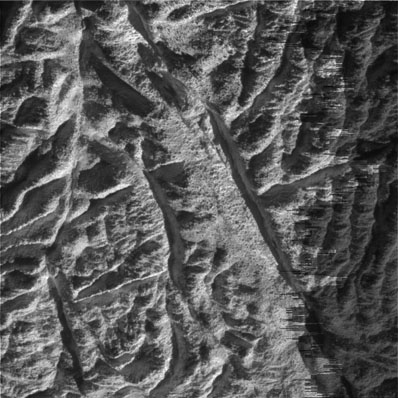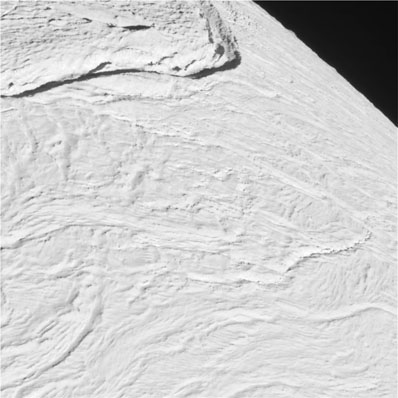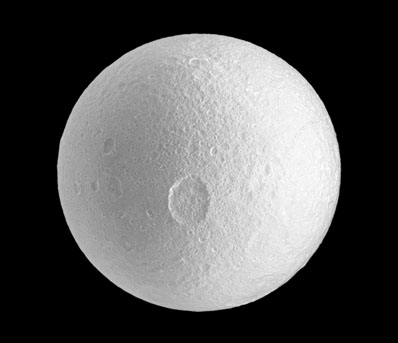




|

|

Cassini images Saturn system as planet's seasons change
BY CRAIG COVAULT
SPACEFLIGHT NOW
Posted: December 8, 2009


The Cassini spacecraft in orbit around Saturn a billion miles from Earth is beginning its new U.S.-European Equinox Mission with a series of high-value passes over Saturn's rings and close flybys of its scientifically most important moons.
Cassini completed its initial four-year mission to explore the Saturn System in June 2008. Now, the healthy spacecraft is working overtime on the Cassini Equinox Mission, seeking answers to new questions raised in Cassini's first years at Saturn.
The flight ended its initial four-year mission in June and was immediately approved by NASA and ESA for an extension to at least September 2010 to observe the major change of seasons, which only occur only every 15 years at Saturn. The immediate effect of this is a wholesale change in lighting angles.
During the equinox itself, Saturn was bathed in more subtle lighting hitting the ring system edge on. The giant planet was resplendent during the few days these specific lighting angles prevailed.

The subtle beauty of the immense planet Saturn and its ring system are evident in this image by the Cassini spacecraft taken during the equinox, when the sun was directly over the rings. Credit: NASA/JPL
|
In August, at the start of this Saturn equinox period, the sun moved from a position directly over the equator, beginning to illuminate the northern hemisphere of Saturn, its rings, and all of the moons' northern hemispheres. This compares with sun angles during the first four years of the flight, which favored observations in the southern hemispheres of the Saturnian system.
The new lighting angles are setting up beautiful new angles for photography as seen in this image of a crescent Enceladus visible as Cassini imaged the scene.

This raw, unprocessed image of Enceladus was taken by Cassini on Nov. 21, 2009. Credit: NASA/JPL
|
Once Cassini arrived at Enceladus on this orbit 121 pass, it obtained the highest resolution imagery of moon, revealing more than a dozen cryo-volcanic jets along with new detail on the rugged terrain around the water vapor vents.
As many as 15 jets have been found in this image by analysts, although 10-12 are more readily visible to the naked eye.

Plumes appear as jets of fog shutting up about 50 mi. above the moon, which was imaged as a crescent to block light that would otherwise wash out the plumes. The image was taken in visible light with the Cassini spacecraft narrow-angle camera on Nov. 21. The view was acquired at a distance of approximately 6,000 miles from Enceladus and at a high Sun-Enceladus-spacecraft, or phase, angle. Image scale is approximately 174 ft. per pixel. Credit: NASA/JPL
|
The jets present a unique window of opportunity for the detection of extant life in our solar system. With its significant geothermal energy source propelling these plumes about 50 mi. from the surface of the moon, and the ensuing large temperature gradient with the surrounding environment, it is possible to have the weathering of rocks by liquid water at the rock/liquid interface.
Cassini swept to within 998 mi. of Enceladus Nov. 21 obtaining 41 ft. image resolution per pixel.
Other flybys have been flown below about 200 mi. to penetrate the water vapor plumes while protecting the imaging optics. That is why the Imaging Science Subsystem (ISS) team believes this latest medium altitude encounter is providing the highest resolution views.
It is ironic that astrobiologists at the Johnson Space Center are using new imaging tools to build a case for evidence of life in their Allen Hills Meteorite, at the same time similar scientists at the Jet Propulsion Laboratory and Space Sciences Institute in Boulder believe the new data from Saturn will help build an argument that tiny Enceladus, only 314 mi. in diameter and a billion mi. from the sun, may harbor life in a subsurface liquid water ocean kept warm by tidal forces from Saturn.
The emphasis moves from tracking vapor plumes above Enceladus to imaging the surface of the body in the picture below.

The image of Enceladus was taken in visible light with the Cassini spacecraft narrow-angle camera on Nov. 21. The view was acquired at a distance of approximately 2,000 kilometers from Enceladus. Image scale is approximately 41 feet per pixel. Credit: NASA/JPL
|
Much rougher terrain is imaged in the picture below, the location on the surface where the tiger stripe terrain opens into vents that tap the subsurface water supply, then blast it skyward.

The rougher terrain is much more evident here. It is dominated by V-shaped grooves with soft rounded sides, indicating that cryo-volcanism blows out of these V-shaped vents then settles back down as relatively soft and rounded deposits. Credit: NASA/JPL
|
One final hemispheric image show a generally smooth white moon with gentle ridge lines until on the far limb appears a spectacular rift valley feature where the terrain appears to have been ripped apart in a violent event. The image below shows the scene.

The image was taken in visible light with the Cassini spacecraft narrow-angle camera on Nov. 21. The view was acquired at a distance of approximately 6,000 miles from Enceladus. Image scale is approximately 55 meters (182 feet) per pixel. Credit: NASA/JPL
|
Cassini has also been imaging the rings and other moons as it moved out with the Equinox imaging program.
Features in the rings, like spokes, and their behavior are of special interest. Spokes have been seen in Saturn's rings since the Pioneer spacecraft flyby of the 1970s. An image illustrating spokes is below.

Spokes, those ghostly radial markings on Saturn's B ring, appear bright compared to the rings in this image taken a little more than a month after the planet's August 2009 equinox. Credit: NASA/JPL
|
Spokes appear bright when they are viewed at phase, or sun-Saturn-spacecraft, angles higher than about 45 degrees. The phase angle in this image is 64 degrees. Also, the contrast is even greater in this image since the surrounding rings are darkened during the equinox period at Saturn.
Saturn's northern latitudes appear dark in this image because of the camera filter used. This view uses a spectral filter sensitive to absorption of certain wavelengths of light by methane in Saturn's atmosphere. In the north, the light at these wavelengths reaches slightly greater depth before being reflected off the cloud tops -- compared to the equatorial region -- and it passes through more light-absorbing methane along the way.
The novel illumination geometry that accompanies equinox lowers the sun's angle to the ringplane, significantly darkens the rings, and causes out-of-plane structures to look anomalously bright and cast shadows across the rings. These scenes are possible only during the few months before and after Saturn's equinox, which occurs only once in about 15 Earth years.
The monitoring of unusual terrain on the moons of the Saturn system as the seasons change reveal new detail about their character.
In this shot, Cassini spies the large Penelope crater on Saturn's moon Tethys.

The Penelope crater lies near the center of the image. This view looks toward the trailing hemisphere of Tethys 660 miles across. North on Tethys is up. The image was taken with the Cassini spacecraft narrow-angle camera on Oct. 14, 2009, using a spectral filter sensitive to wavelengths of ultraviolet light centered at 338 nanometers. The view was obtained at a distance of approximately 159,000 miles from Tethys and at a sun-Tethys-spacecraft, or phase, angle of 1 degree. Image scale is 5,022 feet per pixel. Credit: NASA/JPL
|
In addition to the frozen moons, one of the highest priorities for Cassini during the coming months will be to image the methane lakes around the north polar region of Titan.

In the top right of this Cassini image, the southern end of Titan's huge lake of liquid hydrocarbons called Kraken Mare is visible near the moon's north pole. Near the moon's equator are the albedo features Senkyo on the right and Aztlan on the left. This view looks toward the Saturn-facing side of Titan, 3,200 miles across. North on Titan is up and rotated 31 degrees to the right. Credit: NASA/JPL
|
The image was taken with the Cassini spacecraft wide-angle camera on Oct. 12, 2009, using a spectral filter sensitive to wavelengths of near-infrared light centered at 939 nanometers. The view was acquired at a distance of approximately 157,000 miles from Titan and at a sun-Titan-spacecraft, or phase, angle of 11 degrees. Image scale is 9 miles per pixel.
|

|

|

|

|



